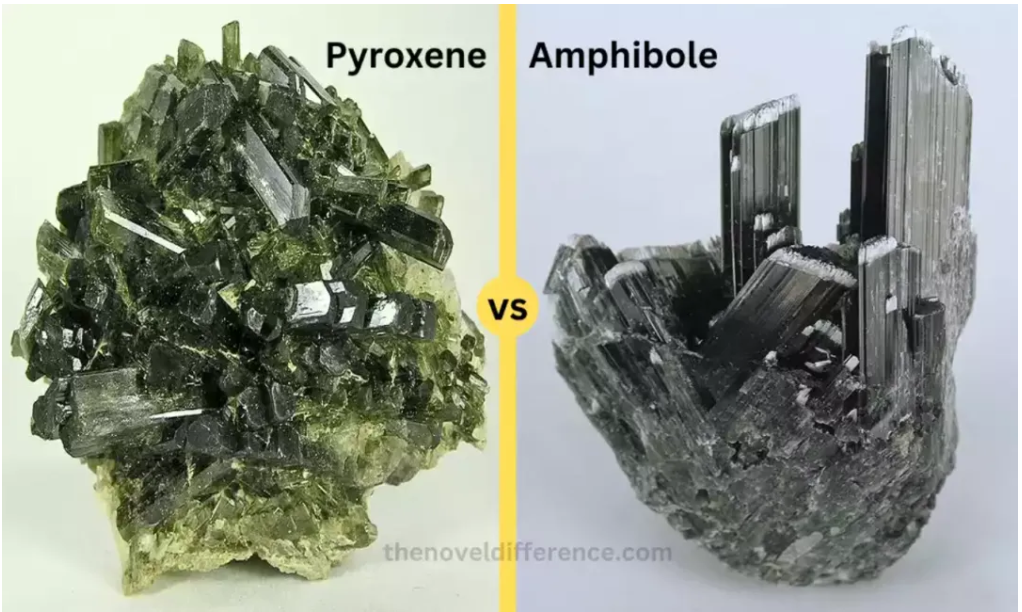博文
Comparison table between Pyroxene and Amphibole
||
Pyroxene and Amphibole, as two major families of silicate minerals widely distributed across the Earth, hold pivotal positions not only in the realms of petrology and mineralogy research, but also carry profound geological implications in unraveling the history of Earth's evolution, geological processes, and resource exploration.Both pyroxene and amphibole are silicate minerals commonly encountered in igneous rocks, and due to their diverse chemical compositions and intricate crystal structures, they can at times be challenging to distinguish from one another. They exhibit certain similarities in color and optical properties and may coexist within rocks, making it difficult to identify them quickly based solely on appearance and simple optical testing. However, they demonstrate marked differences in their microstructure, chemical makeup, associations with rock types, and geological settings. These distinctions render them invaluable tools for geologists in deciphering crustal tectonic changes, rock formation types, metamorphic sequences, and the mechanisms of Earth's internal dynamics.
| Characteristics | Pyroxene | Amphibole |
|---|---|---|
| Crystal System | Orthorhombic or Monoclinic | Monoclinic |
| Color | Varies from colorless to black depending on composition; typically green, gray, brown, or black with increasing iron content (e.g., jadeite is white to green, augite is dark green to black) | Typically darker shades ranging from green to dark green, even black, except for non-iron bearing amphiboles which may be lighter (actinolite can be green, hornblende is often dark green to black) |
| Optical Properties | Exhibits parallel extinction (parallel to crystallographic axes); uniaxial negative | Produces an extinction angle that is generally lower than pyroxenes; biaxial |
| Crystal Habit | Forms short prismatic crystals, often exhibiting cross-sections as square or octagonal shapes | Forms long prismatic crystals, often presenting pseudo-hexagonal or rhombic cross-sections |
| Chemical Composition | A group of silicate minerals with the general formula XYSi₂O₆ where X and Y are usually cations like calcium, magnesium, iron, and aluminum | A more complex group with the general formula XY(Si,Al)₂O₆(OH,F)₂, containing additional hydroxyl (OH) and sometimes fluoride (F) groups |
| Associated Rocks | Commonly found in mafic to ultramafic igneous rocks (e.g., basalt, gabbro, peridotite), metamorphic rocks, and occasionally sedimentary rocks | Predominantly found in intermediate to felsic metamorphic rocks (e.g., schist, gneiss, amphibolites), some mafic igneous rocks, and less commonly in sedimentary environments |
| Specific Gravity | Ranges between approximately 3.0 to 3.6 | Also has a specific gravity in the range of about 3.0 to 3.6 |
| Hardness | Variable but typically between 5.5 to 6.5 on Mohs scale | Generally between 5 to 6 on Mohs scale |
| Important Varieties | Augite, Enstatite, Diopside, Jadeite, etc. | Hornblende, Actinolite, Tremolite, Anthophyllite, etc. |
Please note that while this table provides a general overview, there can be significant variations within each mineral group due to their wide chemical compositions and resulting physical properties. Additionally, identifying these minerals in the field often requires close examination under a microscope and/or through optical tests not detailed in this table.

Figure 1: Although both pyroxene and amphibole belong to the category of dark silicate minerals that often coexist in rocks and share similar colors, they can initially be distinguished by several characteristics: Amphiboles typically exhibit a deep green to blackish-green hue with a pronounced greasy or metallic luster, and their crystal form tends towards elongated prisms, displaying a pseudohexagonal cross-section. In contrast, pyroxenes become darker in color with increasing iron content, showing a glassy or submetallic luster. Their crystal shape is characterized by shorter prisms or granular forms, and their cross-section might present a regular octahedral shape. A key distinguishing feature is the difference in cleavage angles; those of amphiboles are oblique, whereas pyroxenes exhibit cleavages that are nearly perpendicular to each other. Furthermore, the precise distinction between the two can be achieved through optical testing and chemical analysis.
Reference:
Cherniak, D. J., & Dimanov, A. (2010). Diffusion in pyroxene, mica and amphibole. Reviews in Mineralogy and Geochemistry, 72(1), 641-690.
Powell, R., & Holland, T. (1999). Relating formulations of the thermodynamics of mineral solid solutions; activity modeling of pyroxenes, amphiboles, and micas. American mineralogist, 84(1-2), 1-14.
https://thenoveldifference.com/pyroxene-and-amphibole/
https://blog.sciencenet.cn/home.php?mod=space&uid=3549522&do=blog&id=1430357
https://blog.sciencenet.cn/blog-3549522-1430450.html
上一篇:[转载]矿物百科:硫酸铅矿 ( Anglesite)
下一篇:[转载]中国核能技术突破:秦山反应堆实现生产碳-14,有望结束完全依赖进口的局面